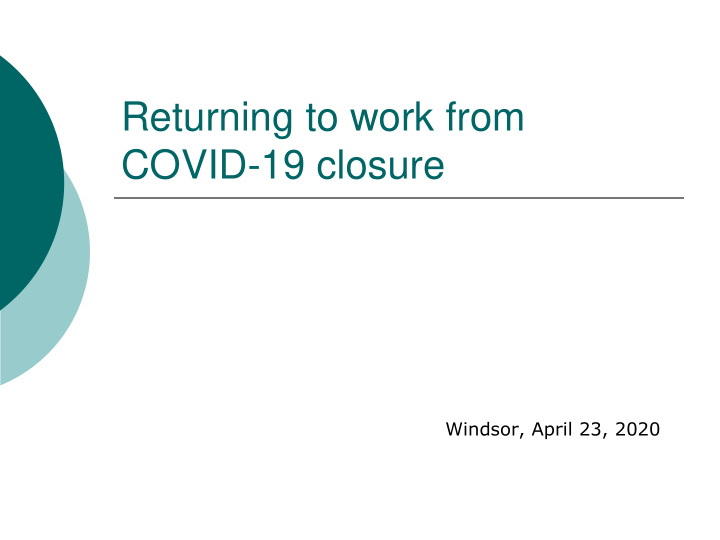



Returning to work from COVID-19 closure Windsor, April 23, 2020
Keeping the Workplace Safe We all have the critical role to play in keeping our facility safe and free of illness and viruses. Each employee is responsible for : Monitoring your health on a daily basis. Notifying your supervisor or HR rep immediately if you are feeling ill or if your health situation and/or exposure to illness/viruses has changed. Staying home if they are not feeling well & informing their supervisor or HR rep 2
What to Expect …. When You Return to Work Employees can start coming into work 30 minutes prior to their scheduled shift. Follow physical distancing signs on the ground and floor in entrance way Two entrance doors assigned to hourly employees (Doors #37 and #38) Shift start and end times have been staggered: Afternoon – 3:00 p.m. to 11:30 p.m. Days – 6:00 a.m. to 2:30 p.m. Company will be distributing face masks based on: Requirement based on job task risk Voluntary – if you choose to wear one 3
Daily Screening Process As you enter the property gate Security Personnel will be conducting daily screenings: Employee Health Declaration Form Temperature Screening Must be within 6-8 cm of forehead for reading Temperatures higher than 100.4 ° F or 38 ° C, employee will be placed in an isolation room for further assessment < 100.4 ° F or 38 ° C = PASS ≥ 100.4° F or 38 ° C = FAIL
Daily Screening Process If the employee is sent home because they did not pass the screening process, they will need to self-isolate . They need to contact their doctor or local health authority to determine whether they need to be tested. It is the employee’s responsibility to inform HR of the results of any medical assessment. HR will be following up with the employee next day. The supervisor and HR will assess what, if any, communication is required at that time to other employees that may have come in contact with the sick employee based on the facts of the situation. The isolation room and the sick employee’s workstation will be thoroughly cleaned and disinfected.
Safe Work Practices Practice physical distancing (6ft/2 meters) while on- site In aisle ways Washroom/Locker Rooms Cafeteria In all Work Areas Avoid high touch surface areas ( i.e. propped doors) Plant has been 100% disinfected prior to you returning to work. Disinfecting supplies will be made available sanitation stations throughout facility
Safe Work Practices To maintain 2m physical distancing enter lunchroom through the east entrance door only (by tool room) exit only through the west exit door (by C-Line). Use respiratory etiquette, including covering coughs and sneezes. Frequent hand washing using soap and running water and/or hand sanitizers PPE will be provided based on your job task. Example: Face Masks, Face Shields, Gloves
Employee Home Self Screening Before you leave your house and report to work, please perform your self assessment. Are you experiencing a fever, cough, sore throat, diarrhea and/or had difficulty breathing? Have you been in close contact (within 6 feet) with a person who was exhibiting the above symptoms or who has been confirmed or is awaiting COVID-19 test results? If you are experiencing elevated temperature, take your temperature. Is it 100.4F/38C or greater? Have you lost your sense of taste or smell? Have you travelled outside of your state or province within the past 14 days? If you answered “YES” to ANY of these questions DO NOT REPORT TO WORK Follow the absentee Call-In Procedure
Personal Hygiene Washing hands is the most effective way to reduce the spread of infectious diseases. YOU SHOULD: Presume that your hands are contaminated with viruses and bacteria after touching common surfaces, as well as anything touched thereafter. Wash your hands upon entering the workplace and before going back home. Hands should also be washed before and after food preparation and before eating and drinking, processing garbage, blowing one’s nose, coughing or sneezing, handling animals or animal waste, changing diapers, visiting sick people or before taking medication.
Keeping ourselves healthy and safe must be our first priority. Everyone has a role to play.
Recommend
More recommend